When your hobby also happens to be your livelihood – which is the case for embroidery and me – it’s sometimes necessary to pursue a different hobby now and then!
I have a couple hobbies that are not needle-and-thread-related pursuits, but I don’t often indulge in them anymore simply because there’s not a lot of time outside Needle ‘n Thread for other creative activities.
But over the recent Easter break, I took some time to focus on setting up a non-embroidery related project (who knows – since it involves cloth, it may morph into an embroidery-related project!) that is still needle-and-thread related, and since some of you wrote in and asked about it, I thought I’d show it to you.
There are a couple tools and accessories involved that you might like, too, so I’ll share those with you as well.
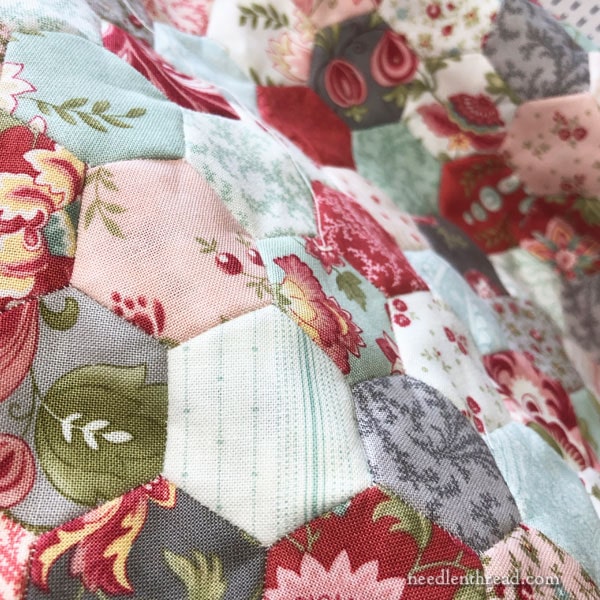
The project is a hand-pieced quilt – specifically, a hexagon quilt using English paper piecing.
I made a hand-pieced quilt once before, years and years ago when I was finishing college and starting to teach. It was a pineapple design, 49 pieces in each 8″ square, made from random scrap fabric and occasional purchased bits. There was no real color coordination in it – it really was random! – except for manipulating the placement of light and dark fabrics.
For quite a while now, I’ve wanted to make another hand-pieced, random quilt, using English paper piecing and hexagons.
You see, I like hand piecing. It’s such a portable way to have something to work on. And I’m often in situations when my hands need to be doing something, but I don’t have an embroidery project to tote around.
I also like the whole basting process of English paper piecing. It’s mindless and relaxing.
And I like working with little things. The hexies are small, at 3/4″ along each side.
In short, I like the process, the portability, and the fabric – which is why I finally took the plunge.
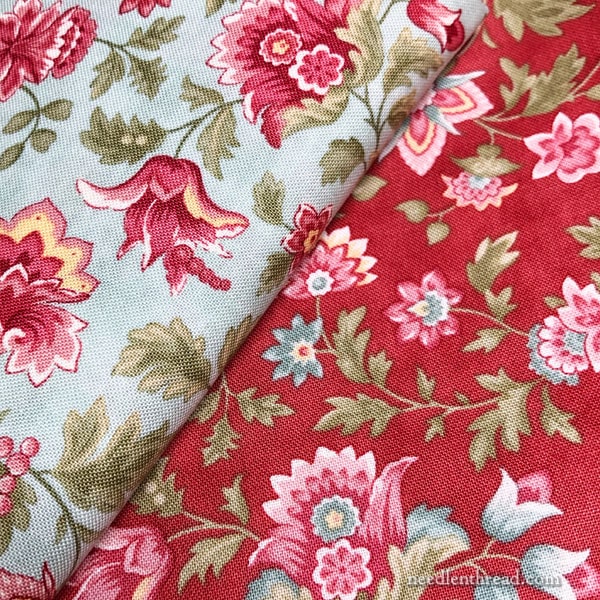
Speaking of the fabric, earlier this year, I was looking for Jacobean-inspired fabric designs, when I came across a fabric line that I really liked, called Porcelain from 3 Sisters, produced by Moda.
The colors and the designs were appealing to me, and the designs were small enough and varied enough that I thought they’d work well for little hexies. So I started collecting the fabric, though I wasn’t really ready to start the project.
It’s a funny thing about cotton quilting fabrics: If you like a fabric and you plan to do something with it, you better get it (and enough of it for your project) while you can, because next year, it won’t be around. This, I think, is what prompts quilters to “stash.”
So I did what I normally wouldn’t do, and I purchased all the fabric I would need for a quilt made from this particular fabric line, and I “stashed” it. My plan was to start this quilt some time this spring, so I figured it wouldn’t be stashed for long.
Incidentally, I don’t have a fabric stash. I have some cuts of linen that I use regularly for embroidery, but I don’t have a build up of different kinds of fabric. I don’t have space for that, and I’m not really a quilter and I don’t sew much, so I’ve never had a reason to stash fabric.
Still, warning bells went off in my head! You Cannot Become a Fabric Collector! they cried. And they are right – I can’t. So to put those bells to rest and to make myself feel better about the fabric purchase, I set aside time over my break to focus on getting this project underway.
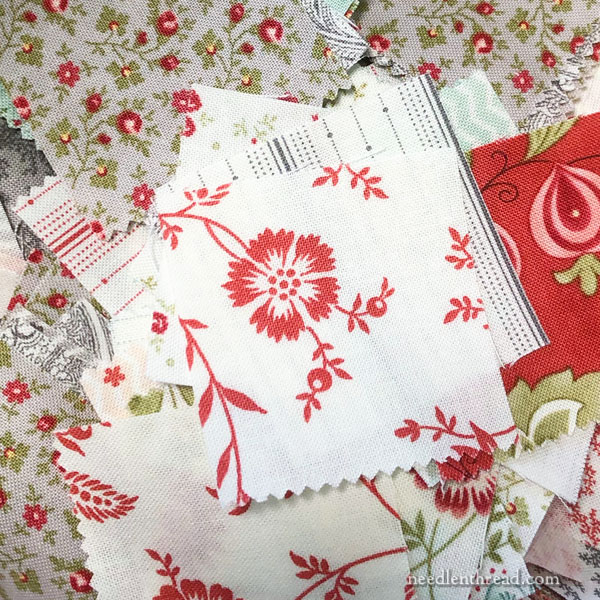
I sliced up the fabric into squares. To make it easy and more affordable, I bought the fabric in “layer cakes,” which gave me a little bit of the whole range. One piece of fabric in a layer cake (which is made up of 42 10″ squares) produces 25 2″ squares, perfect for 3/4″ hexies.
Because I’m doing English paper piecing, I don’t have to cut the fabric into hexagon shapes. Instead, I baste the squares around a paper cut out of a 3/4″ hexie, and once the hexies are sewn together, I pop the paper out.
So I sliced up a bunch of 10″ squares into 2″ squares. The quilt requires, in fact, 5,174 hexagons. Ummmmmm… no comment… I cut about half the amount I need, because I got sick of cutting. Even with a good ruler and rotary cutter, this kind of cutting is not my favorite activity in the world!
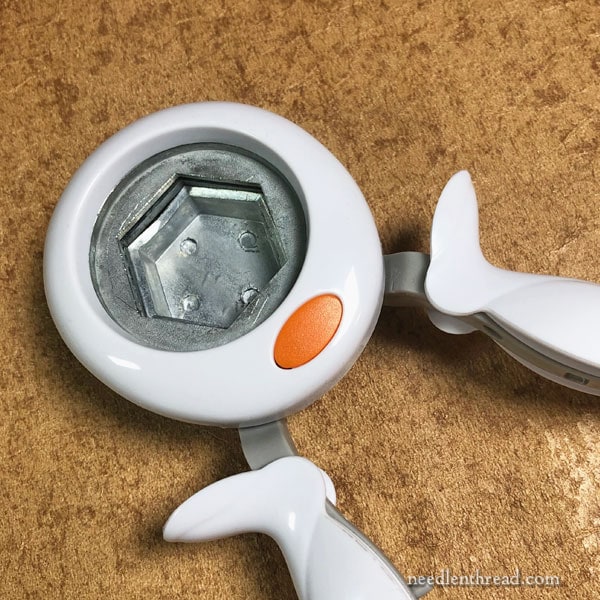
For the paper piecing part of things, I could have ordered a bunch of pre-cut hexagon papers, but I knew over time, I would need a lot of them! So instead, I bought a relatively inexpensive Fiskars hexagon paper punch, and I’m punching my own papers as I need them, using light card stock and scrap paper.
At first, I organized a small tin with some stacks of fabric, some paper hexagons, needle, thread, and scissors in it, but the open tin concept didn’t keep things organized enough for me.
It just so happens that DMC recently released a small fabric sewing box, and it just so happens that I bought one because I really wanted to see it up close and examine its features.
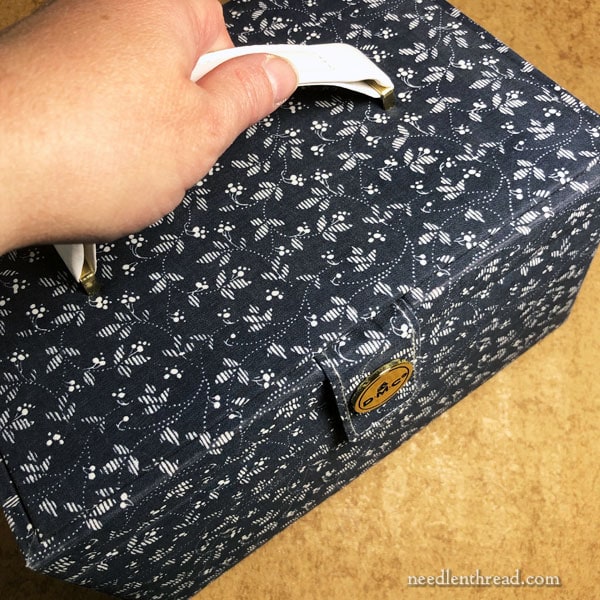
It’s definitely not your typical fabric sewing box, like the type you’d find at fabric stores here in the States. It runs more along the French “cartonnage” box making style, and it’s nice. I like it a lot!
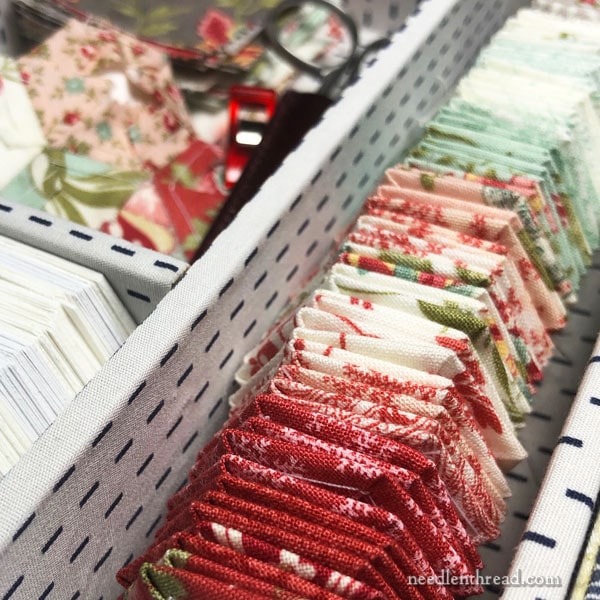
And, wonder of wonders, the 3/4″ hexies fit in it like it was made for them. Joy, bliss! I ditched the tin for the box.
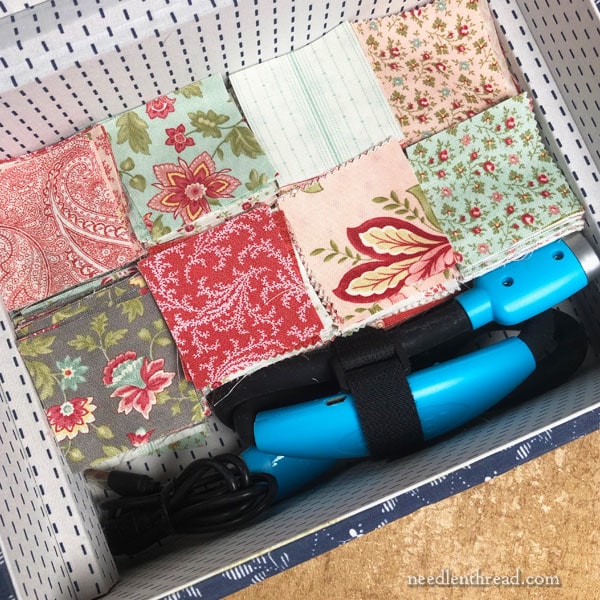
In the base of the box, I stacked in a bunch of the 2″ fabric squares and threw in my twisty neck light and charger. I will tell you about that below.
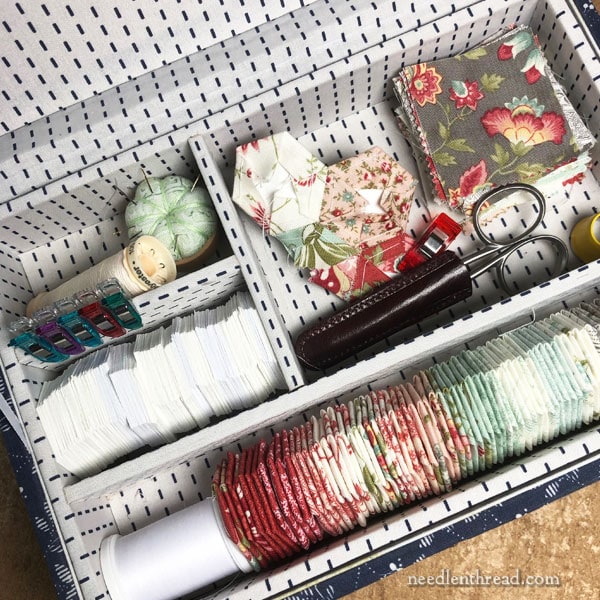
In the top tray, I have a section with paper hexagons, a section where I put basted hexagons, two spools of thread (one for basting, one for piecing) and the tools I use, which are minimal: a pair of scissors, a tiny pincushion, a thimble, and some miniature Clover clips.
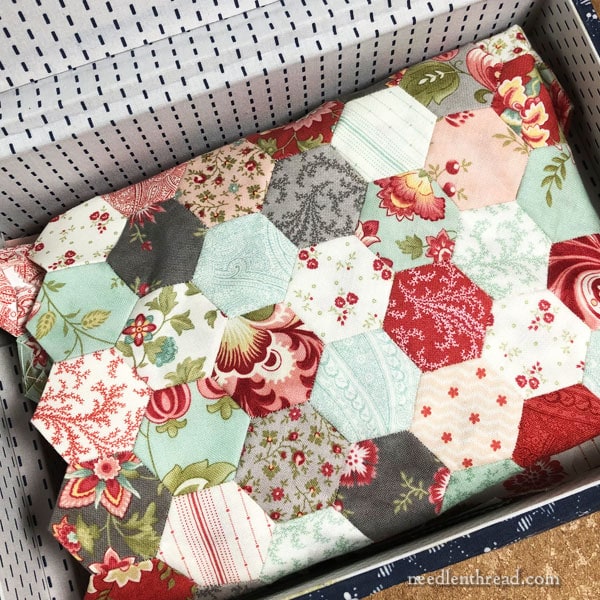
And now I have a completely transportable little box for my English paper pieced hexagon quilt that will probably take me ten forevers to complete. But hey! I won’t lack for something transportable to do with my hands!
The Neck Light
Concerning the neck light: this was recommended to me by another stitcher as an easily transportable light for sewing in dim places.
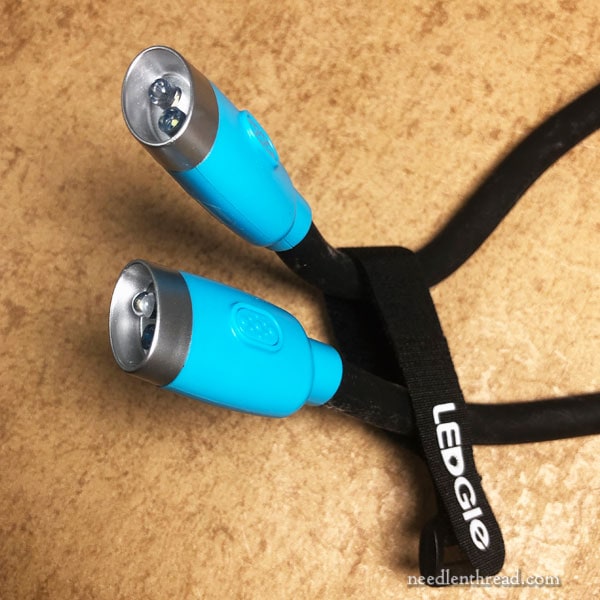
It has flexible rubber-ish rope sides that end in two little light heads, and the two sides (after being placed on your neck) can be held together with the Velcro strap. The “ropes” can be manipulated, so that you can direct the lights where you want them.
The whole apparatus is rechargeable, and it comes with a micro-USB cable. Overall, it struck me as good concept, so I got one to try, thinking I could review it for you if it proved to be useful. After all, it might work well for portable workshop or seminar lighting and so forth.
Like I said, it’s a great concept! And I wish I could recommend it without reservations! It’s comfortable enough, it’s easy to manipulate, it gives off decent, directed light to use in dimly lit situations. It’s rechargeable and it’s affordable (you can buy two of them for around $30, so you can switch off while one charges) and the battery lasts a good four to five hours on high.
However, the second time I used it, one half of the thing wouldn’t turn on. I’m going to send it back and get a replacement. In the meantime, I wrote a poor review on Amazon. After all, even if you’re purchasing something for only $16, you expect all of it to work for longer than 24 hours!
So I recommend it with reservations. Maybe I just got a dud. I’ll update you on it, when I get this one sorted and test a replacement for long enough to judge it better.
Not a Quilter!
Well, I’m not a quilter, when it comes to making quilts regularly or frequently. But I like hand piecing little bits of fabric into a quilt and hand quilting. (Does this make me a quilter?)
Still, I won’t be writing about quilting here on Needle ‘n Thread. There are a gazillion quilting websites out there that can teach you and inspire you a lot better than I ever could on that subject!
But as far as embroidery goes, I should admit that a little part of me wants to pick out elements in the fabric design and embellish them with a touch of embroidery, just for the fun of it – and so that my “ten forevers” project can turn into an infinity project. That might be a little nuts.
If I ever do it, though, I’ll let you know!
Where to Find Stuff
I have no idea where to find the Porcelain fabric line these days. I originally bought my “layer cakes” through Missouri Star Quilt Company. I had to buy the yardage for the backing somewhere else, because they were already out of yardage for most of the line by the time I discovered the fabric. If you like the fabric and want to find it, your best bet is probably Google – “Porcelain from 3 Sisters by Moda” is what you’d look for.
You can find the little sewing box (and a much larger version) on the DMC website here. The box is super sturdy, and it seems quite well made to me. I like it a lot! It’s on sale for $28 now.
You can find the Fiskars 3/4″ punch (the “large” punch) and the light both listed on my Amazon recommendations page here. I’ll leave the light there, in case it’s something you’d be interested in trying. Again, my recommendation comes with some reservations at this point, but I’ll update you once I get my light sorted.
Back to It!
I’m back to embroidery these days – and lots of website work. Some changes coming up for Needle ‘n Thread! I’ll talk about them soon!
I hope you’re making progress with your needle and thread projects!
This article includes an affiliate link to my Amazon Recommendations page, which means Needle ‘n Thread receives a small commission for orders placed through that link, at no additional expense to you. Every little bit counts! Thanks!







Good job! And you are so organized!
I started a Lucy Boston Patchwork of the Crosses and it will definitely take awhile. But it is relaxing.
Cécile Franconie has a couple of books out where she combines quilting and embroidery. Some of them have a ‘crazy quilt’ look with the different stitches.
Good luck!
Thanks, Robert! I look those books up!
Oh my goodness, miss Corbet, I love your quilt-in-progress!!!
Would you believe I have this fabric series bookmarked as a favourite?
I’m not really a quilter either, but I’m afraid I do have a bit of a stash, and I can’t help but check out new fabric lines and save my favourites into a computer file 🙂
Fortunately I have been able to restrain myself from actually buying them, since I wouldn’t have a specific project for them yet, but I won’t deny I’m tempted lol.
It really is a lovely family of fabrics! I’m glad to know I’m not the only one who loves them!
Hi Mary,
I have one of those neck lights too and I find that sometimes it is difficult to get it in exactly the right position as my neck and shoulder bones are just not in the right place to support the bendiness. Also, it tends to get knocked when in the storage pouch and gets switched on so the charge is wasted.
Love your hexagons and the fabrics you are using. I have found over the years that the stiffish shiny paper that travel brochures are made of is exactly the right weight for paper piecing. Have you tried that yet rather than buy card.
PS the print has not come off on the fabric yet.
Hi, Lesley-Anne – I’ve used a bunch of different scrap things for punching the hexies. But right now, I’m using 65 lb card stock because I did a whole print run on card stock, but it misprinted and left me with a whole stack of half-blank pieces of card stock. It’s been sitting here in my desk drawer for a while now, so I’m glad I can finally put it to work and get rid of it! I’ll keep an eye out for travel brochures. Ut oh – I’ll have to stop myself from nicking them from travel plazas and hotels and whatnot by the stack. Oh my!
Dear Mary
It’s sometimes nice to do something different I like to vary my projects some embroidery, fabric journals, dabbled in egg embroidery, fabric/felt quiet books and just recently I bought the Folk Embroidery Felt Birds which you recommended and since made a Hen and Dove which I really enjoyed making. I think alternative projects broaden the mind and give you different experiences which can help expand your knowledge for embroidered projects. The material on your quilt is lovely and I do like your DMC fabric sewing box. Thanks for sharing with us your secret non-embroidery related needle and thread project it’s great.
Regards Anita Simmance
Hi Mary,
If you punch a hole in the middle of your hexi paper pieces you will be sooooo glad you did later. With a hole in the center a pencil or chopstick can be inserted for paper removal. They pop right out.
Hi, Sharyn – Thanks for the tip! I started by punching holes in the middle with a hole punch, but after a while, I gave it up. I figure why add another step and put my hand through the “hole punch stress”? So now I’m doing it without the holes, and I’ve found they pop out the same, pretty much, either way! My hands are much happier!
Ha, I have also found that paper piecing is surprisingly enjoyable and doesn’t actually take as long to do as one might think. My first project was a little decorative table thingie to put under a vase of flowers or some such, and it looks like my hexies were about the same size as yours. I gave it to my mum for her birthday the other day, actually. Currently Husband challenged me with pentagonal tiling (https://en.wikipedia.org/wiki/Pentagonal_tiling#Mann/McLoud/Von_Derau_(2015)_Type_15). Seriously beyond me maths to work out how many pentagons necessary! Starting with 225 and then we’ll see. My friend calls me a complete nutjob, and I’m willing to admit that she may have a point. 🙂
That sounds very challenging! But kind of fun and exciting, too! Good luck!! LOL!
Hi! I loved this article – I’ve been wanting to learn how to make a quilt by hand. I’m disabled and don’t always have the strength in my legs and feet to press the foot pedal of my sewing machine. Would you please point me in the right direction to find articles or videos to teach the technique you are doing?
Thank you in advance!
Hi, Sharon – If you google “English paper piecing hexagons,” I’m sure you will find a whole bunch of tutorials. videos, and blogs to read and learn about the process. It’s a very popular form of quilting with hexagons and other small non-standard shapes. Hope that helps!
Thank you for the great article! Your project is going to be beautiful.
I am a quilter who is now adding embroidery to my quilts and fabric art.
I am finishing the quilting on my hand pieced quilt and am adding embroidered details. I love this ‘loving’ touch of personalized details.
I follow your emails and always look forward to your next project.
Love it!! Organized very much like my hexi quilt project. I did hand quilt and then embellish with lots of embroidery!!! Couldn’t resist!!! Wish I could share a photo on here bc the result was really really cool!! Maybe I’ll put on our FB page!
5,000 +, less than 2″ in size, hand stitched pieces???? I am beginning to question your sanity! That is amazing – I wouldn’t have had enough time to do something like that if I started at 12 and lived to 104 – hope we get to see the finished project!
A few years ago, I came to the same realization that I liked hand piecing more then machine sewing fabric together for all the reasons you listed above. I purchased a book by Jessica Alexandrakis called “Quilting on the Go” and from there I set up a portable ‘to-go’ box. I have only done small projects so far to use as a light cover and stitching mat.
I made a new rule when I retired 5 years ago. All hobbies (and stashes) combined must fit into one closet and be organized enough to find what I need. If it spills out, it goes.
Hexies are not only addicting to do but I absolutely love the charm of how they look.
Hi Mary, love your quilt! Actually you are a “piecer” if that is a word— because quilting is when you stitch three layers of a quilt together (backing, batting and quilt top). We piece the fabric pieces to make the quilt top—in your case adorable hexes. To quilt it—all of your fantastic embroidery skills could be used to create a design. Quilting is also very fun any hand and only requires a design and a needle n thread.
Yes, that’s true, I suppose, if you want to get technical! LOL! I know very many people who call themselves quilters, who sew their quilt tops by machine and send them to a long arm quilter to quilt. I suppose they use the term to mean “people who make quilts” rather than to mean “people who are hand quilting.” 🙂
Just had to say that I always enjoy your posts and I learn things along the way.
And today’s story was just so enjoyable- I don’t really know why- it’s probably because it was so down to earth like friends chatting.
Anyway, it made me smile and I thought I’d let you know.
Fondly,
Patty
Thanks, Patty! I’m glad you enjoyed it! Gosh, I think you just made my day! 🙂
My head is saying “Do NOT let Mary enable you!” but my heart is saying “ooooh pretty! where are the clicky-links?” I know you don’t want to become a fabric stasher, but when I see gorgeous fabric that I must have but have no immediate plan for, I buy 3 yards. That should be enough for just about anything! XO
LOLOLOLOLOLOL!!!! I’m sorry, Buffy. Three yards sounds like a good rule, though, doesn’t it?!
I will admit to three fiber hobbies – needlework being one and quilting being another (knitting is the third plus just a bit of handspinning).
I am currently working on an English Paper Piecing project, though just a table topper. Have you heard of the Lucy Boston “Patchwork of the Crosses” quilt? Love the portability of EPP.
I haven’t, but I will look it up! Thanks, Karla!
Your article on hand piecing a quilt was a surprise to see and is very interesting. As a primarily quilting person I confess I have a huge stash of fabrics (but often can’t find just the one I thinks will suit). I too have some EPP projects for toting around, most notably a Grandmother’s Flower Garden and a charm Tumbling blocks. These have been in the works now for 30 years so congratulations on completing your pineapple quilt in such a relatively short time.
A totally handpieced quilt is a treasure and I love the line of fabrics you’ve chosen for this hexagon one.
Have fun stitching these simple stitches as you plan your next embroidery project. ~ Brenda
Thanks, Brenda!
Your hexagons are lovely! I’ve seen pretty hexies that are embroidered with the motifs in the fabrics. English Paper Piecing happens to be a passion of mine, as well! Out of print fabric can often be found at Etsy. Good luck on your long term project!
Thanks, Stacy! I’m sure enjoying it so far!
Good luck with your project! It’s fun to make a change, plus I’m betting you’ll embroider SOMETHING before you’re done…I know I wouldn’t be able to resist all that open space. I had looked at the DMC boxes, but hesitated because of the cost. There wasn’t a lot of detail about the construction and weight. How sturdy are they, and are they light enough to be truly portable?
Thanks for all the great work; I really enjoy reading your new posts and love to go back to ones I missed or skimmed over before.
Hi, Barbara – I think the boxes are surprisingly sturdy. I was half expecting to be disappointed by them. But I’m not! The big one is heavy – it can be carried around, but it is not light. It’s not like a plastic box. I use it as a kind of decorative / useful / organizational box that I can place on a table and work from, if I want, or I could place it by the side of a chair. But I wouldn’t tote it all over the place for quick appointments and whatnot, like I’d do with the small one. Now, if I were going somewhere for several days (driving), I might take it with me to have a thorough work box, but it would not be a box for toting stuff quickly, on the go.
The inside section walls are fabric covered wood or some kind of pressed wood composite or something like that. They’re very firm and they don’t bend or anything.
The small one is fairly small – as you can see in the photo with my hand – but it’s roomy enough and light enough to be very easy to carry. The handle is nice. The boxes don’t feel cheap and cheesy at all! Keep in mind, I haven’t had them for a long time so I can’t speak for absolute longevity, but I’ve been using the small one quite a bit, carrying it everywhere I go just in case I have down time. It’s holding up perfectly. I’m glad I got them.
Thanks for taking the time to reply. It’s nice to hear these boxes are a sturdy as they look. I’ve been disappointed in the past by some that looked good but ended up being made of very flimsy materials. Your display of how you used your box gives a nice idea of the actual utility…it’s so hard to judge by a picture of an empty container.
Good luck with your hexies!
Oooooh boy – talk about serendipitous-ness!!!!!! I have been in like with hexxie projects for ever so long, but have been resisting the thought of ever tackling one, simply because I do NOT have space for any other fabric obsessions on top of those I already have. My current stash does not lend itself to an over-abundance of appropriate cottons so I keep telling myself that I don’t have the fabric so therefore….(well, you get the drift). So….the serendipitous-ness-ness of this entire thing comes in when I make mention of the fact that a book on English paper piecing just “happened” to come home with me from the library this very day….and then I see this post. See what I mean? Serenipitous!!!! And dang Mary – now I REALLY want to succumb!!!!
LOL! Succumb! DO IT! This is The Thing: I, too, cannot afford (and do not want) any extra fabric stashing going on in my life. That’s why I bought the fabric the way I did. I just waited until I found a line of fabric that I fell in love with, that came in layer cakes, jelly rolls, and whatnot, so that I could buy exactly the amount I needed, get the “full line” of prints, and not have anything extra. That was my plan, but I never rushed on it. I’ve been nursing the idea for probably two years now. And when I saw this line – in particular, a few of the Jacobean-style prints in it – I said, “Gosh. I love that fabric.” So I looked up the whole line. And then I said, “Hey, I LOVE that fabric!” And I started looking for layer cakes. I already had the hexie punch, so once I had the layer cakes, I just needed some time to devote to cutting and setting up a transportable box or bag for the project. With that done, I could start. I’m in absolutely No Hurry for this project, whatsoever. I plan to be able to take it with me on vacations or road trips or whatever for years to come. I already take it with me when I stop in at my sister’s house for a little natter now and then, and I take it home with me at night, to work on when I don’t have any embroidery. I’ve taken it to a couple appointments where I had to wait in waiting rooms for someone else, and I’ve taken it to the park. It’s a handy little transportable project, but it’s also a slowly developing project. I’m not going to rush it. I’m glad I have it. Whether or not you’d love doing it as much as I do, I can’t say. But there’s something about it that makes my little heart happy!
Wow! Love the box, never tried paper piecing, all those hexies mean a lot of repetitious work. You win the gold medal for perseverance. 🙂 I like the look and idea of quilts: beauty and practicality in one. But I don’t seem to have the patience. I’ve made a few, one for each grandchild. But I’m back to plain needlework again. Not always practical (you should see my pile of finished but not finished up projects) but it still makes my heart happy.
Mary! How funny!! Last week, I started cutting out hexagons (1.5 inch) for a “slow” handwork project. I’m using all French General fabrics and not doing paper piecing (which I have done before) but am hand-piecing them in the traditional manner (w/a quarter-inch seam). This means that I draw around my little cardstock/plastic hexagon onto the fabric, cut them all out, design layouts, and then sew them together. I wanted a project to pick up on the extra tired days when I don’t have much energy left (I am including French General solids too, so I can embroider hexies throughout the quilt as well). One of my best friends is visiting over the next four days and wants to learn embroidery (she’s a quilter too), so we’ll be in heaven chatting and stitching over the next few days. I’ll be sure to send a picture of my progress once I have a big enough patch of hexies sewn together. So fun you shared this today!
Oooooh – that sounds like a fun visit, Cate! I need a friend who visits and does stuff that I do. LOL! Well, I have several sisters who do, so I can’t complain! I’m doing this project, I guess, pretty much for the same reason. It is a great low-energy handwork project! Have fun with your visit!
Embroidery and patchwork seem to go well together! My favourite embroidery book, Embroidery Mary (by Priscilla M Warner), also includes instructions on making paper-pieced hexagons for a quilt. And then it suggests feather-stitching over the joins.
Oh, yes, that would be fun! But it would be a bit fiddly, perhaps, on this size hexagon? It might be something I experiment with down the road. Thanks, Deborah!
Beautiful fabric choice! Do you trim the fabric squares after you baste them into hexies? You can check out a paper-piecing blog if you are so inclined – Flossie Teacakes – she does amazing work and loves to work with tiny pieces of fabric.
Nooooooooo! I don’t trim! Yikes! That would be too fussy. The 2″ squares baste very nicely onto the 3/4″ hexie papers. It’s true that there is, perhaps, a little more bulk than if the fabric were cut into hexagon shapes with a 1/4″ seam allowance, but it’s just not enough to bother trimming! Thanks for the blog recommendation – I’ll look it up!
Your piecing is so beautiful and neat! And the colours are gorgeous.
Love your little hexies! And the fabric is just gorgeous!
This can be much more interesting. There are glue sticks that make the wrapping fabric around the paper go much faster and don’t damage the paper so it can be reused. Then fussy cutting certain patterns in the fabric makes interesting patterns. You can also applique small groups of hexes to a background fabric and make them into flowers with embroidery or things like rick-rack. So many possibilities!
Yes, many possibilities! I have the sewline glue stick / pen thing, but I don’t really like gluing as well as basting. It seems that the hexies hold up better, basted, and I seem to get a much tighter, crisper hexagon. Plus, the glue stick goes very soft if you have to leave your work in the car (guess how I know…). This particular fabric lends to fussy cutting some of the fabrics in the line. Some, it wouldn’t matter. But I’m not fussy cutting any of it. I like the randomness of doing it the way I’m doing it, and I like the fact that there’s absolutely no fabric waste. It’s a great fabric line for random – each piece is a little surprise when I go to baste it. They always have some aspect of the design on them, and some of them are really exuberant, while others are just the perfect little understated accent. I really like the fabric line!
Just a bit of help from a quilter who also does some embroidery (as opposed tothe other way around). For any of your readers looking for the Moda “Porcelain” by Three Sisters — they can find what the quilting world calls ‘pre-cuts’ at Burkholders Fabrics – a lovely quil;t/fabric shop near Lancaster. PA. They
have the 10″ squares (called layer cakes), 5″ squares (called charm packs) and 2.5″ strips cut the width (44″) of fabric (called jelly rolls). Each precut will have the entire collection of fabrics, and there may be some duplicates. Burkholder’s prices tend to run a bit lower a than may fabric/quilt shops and right now, they are have a 20% off sale
Ahhhhh. I Love Sales! 🙂 Thanks, Katherine!
Just a question about your quilt, which looks like it is your usual lovely work. How are you going to quilt it when you are finished with the piecing? Will you have it machine quilted or quilt it yourself ? Would you consider hand quilting it?
Well, at this point, my plan is to hand quilt. Hahahahaha. In reality, I will probably have someone else do the finishing, because by that time, I may very well be sick of it. But we shall see! You’ll probably have to ask me again in about five years! LOL!
I love EPP! I have made an EPP “Grandmother’s Flower Garden” for my daughter & her husband, it is queen-size and I still need to quilt it. I’m going to try to do it by hand, too. My hexies are 2-1/2″, so not to bad. I, too, use the Fiskar’s punch (do you know they have a lifetime warranty)!
I really wish I had the sewing box, that is cute! My work is usually carried everywhere in a plastic “shoe box” – not very pretty!
I’d love more details about the quilt itself.
What is the finished size?
How many layer cakes did you purchase?
How do you assemble the hexies to make the top?
The finished size is a full size (or double) quilt, so approximately 80″ x 95″, with about 62 columns of hexagons and 85 rows of hexagons, with a total of 5,174 3/4″ hexagons and 84 half hexagons. That’s just for the quilt top – it doesn’t include any border or binding.
I purchased 6 layer cakes, which gives me 6,300 2″ squares. I also purchased yardage for a border and for the binding, as well as yardage for the backing.
The hexies are individually whip stitched together.
Mary,
I’ve not heard of this, and probably should have researched it before commenting here, but does the paper stay inside the fabric that you are basting? And exactly what is basting? I’ve down sewing of stuffed animals back in junior high school, and am presuming that you are stitching the fabric around the shape of the hexagon? I would love to see how you do this? Please?
I love that you have this project, and I saved it on my feedly so I can refer back to it…But I, and am sure others, would love to see more of this. Whilst it’s not embroidery as you say, it is work with our hands in sewing and that is just as much of an embroidery project as any other, imho.
Hugs and Love,
Jen
No, the paper gets popped out as you sew the hexagons together. You leave the paper in on the outer hexagons when you’re sewing a large amount of them together, but once you’ve sewn new ones on, you can remove the ones in the middle of the sewn-together cloth (which makes it easier to fold it up and hold it and so forth as you build your quilt).
Basting is just sewing a “holding thread” on anything, whether it’s a small hexagon or a blouse or skirt or anything you’re sewing, to hold pieces of cloth together until they are more securely sewn. Basting is often done with a running stitch and no knot on either end. With the hexagons, it’s done with a small stitch that catches the fold of the fabric around the piece of paper, to create the shape.
If you google “English paper piecing hexagons” you’ll come up with a bunch of videos and photo tutorials that will demonstrate how it’s done. It’s very easy! But it is more time consuming than, say, sewing a quilt on a machine or drawing 1/4″ seam allowances on pre-cut hexagon shaped pieces of fabric. The advantage of English paper piecing is that it is very precise — and it’s pretty addicting, once you start building a supply of pieces to piece together!
Hi Mary,
I love quilting and embroidery and you are a tremendous inspiration!!
I have watched other quilters become hooked on the hexies and managed to steer clear of the tedious work myself.
However, sharing your work and pretty fabric broke down my resistance and I can’t wait to start!! I love the little DMC box, but was disappointed to find that after your post and positive recommendation they have returned to the regular price of $35.
Seeing those hexagons sure brought back the memories. My grandmother made that kind of quilts. I have one and was amazed when I realized it was hand stitched. She owned a ladies wear store and did alterations in the back. I can still picture her treadle sewing machine there – she liked that better than the electric ones because they went too fast. I think some of the hexies came from material that was cut off when she shortened dresses and skirts for people.
You could always do some Crazy Quilting here and there… That’s embroidery
Thanks for reminding me that I have a cathedral window that I started a long time ago. I was using scraps from other projects for it. Now over the years, I’ve had a lot of fabric that I’ve purchased and that has been given to me. Love your hand piecing. Your work is impeccable. Now I need to go and pull that out and add it to my portable projects. I have a small cosmetics/overnight bag that I re-purposed for tatting. I think there is plenty of room for adding the cathedral window to it as well.
This is a delightful project Mary and I can see why you fell for the fabric selection! These colours and patterns are so pretty. It is nice to have a change of hobby, even when it’s not your job (I regularly switch between embroidery, photography and nail art depending on how I’m feeling!) so I can understand why you will enjoy the variety of patchwork. And I completely get the potential danger of fabric stashing! Those quilting fabric packs are like sweets in a sweet shop for stitchy oriented people … very hard to resist!
In the random way that internet research drives you to sites you never would have found on your own, your blog on your hexie storage definitely caught my eye! I was so entranced by the marvelous DMC storage box that I immediately ordered one for myself.
Eventually, it arrived and then I realized that … holy smokes! .. I hadn’t bookmarked your blog entry to see how you actually put your hexie stuff in the box. I figured why should I reinvent the wheel when you’ve already done it. 🙂
It took a little bit more internet research until I used the right combination of search terms, but I did re-find your blog. Oh hooray!
So, thank you for posting that information; I sure appreciate it.
Note: I’ve now bookmarked your blog and if you have an RSS feed, I’ll subscribe to that. 🙂
Thanks, Shelley! I’m glad the information came in handy. It’s a sweet little box, and it’s still doing it’s job just fine. Don’t overload it, though – I noticed that, if you put too much stuff in it, the handle starts pulling on the box top. I decided to remove things like … whole sets of magnets, an extra pair of scissors, and I reduced the stacks of pre-cut fabric that I had stuffed in the bottom by about half, which relieved the handle considerably.
Mary, I really enjoyed reading about your hexie quilt today, it is beautiful! What is the finished size? The fabrics are gorgeous. Your work is amazing.
It will be a full-sized quilt. I can’t remember the exact dimensions, but it’s full-sized.
I am fascinated by everything you do. You are so incredibly talented and have inspired me to delve into the world of hand embroidery. Your videos and blog have helped me so much. I think I’d like to try hand quilting as well. Thanks for all you share!!
I love the DMC little sewing box. I realize this post was from 2019. I would really like the box but I can’t seem to find it anywhere. I looked on DMC website but no luck. Just wondering if you might know another source.
Thank you
Hi, Marsha – I don’t think it’s available anymore. It was a short-lived item. After a couple years of using it, it definitely showed wear and tear. I think if I were going to invest again in this type of box, I’d either make it myself, or I’d look for a wooden variation of a tool / sewing box that gets better with age!